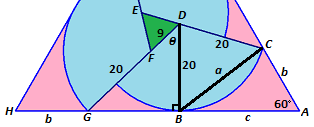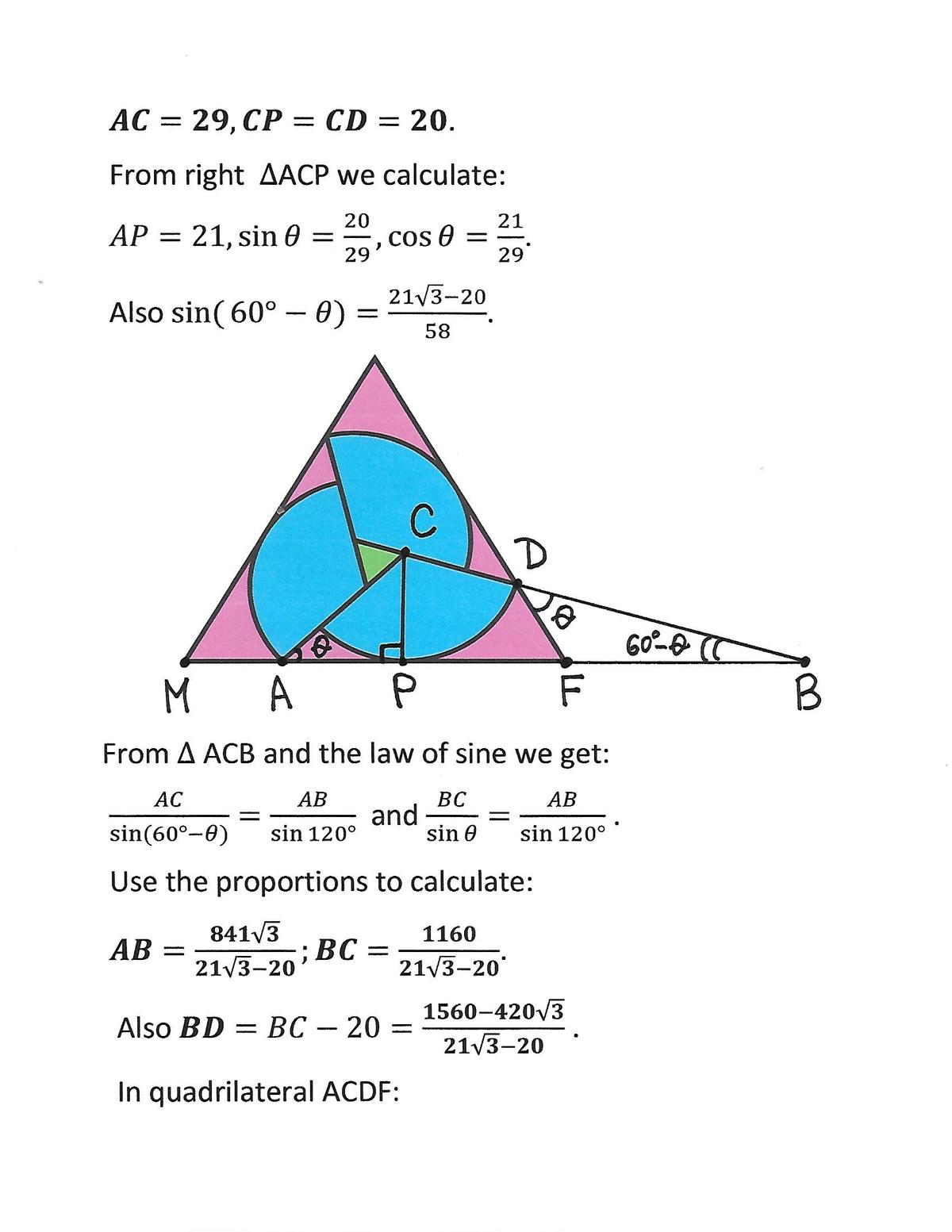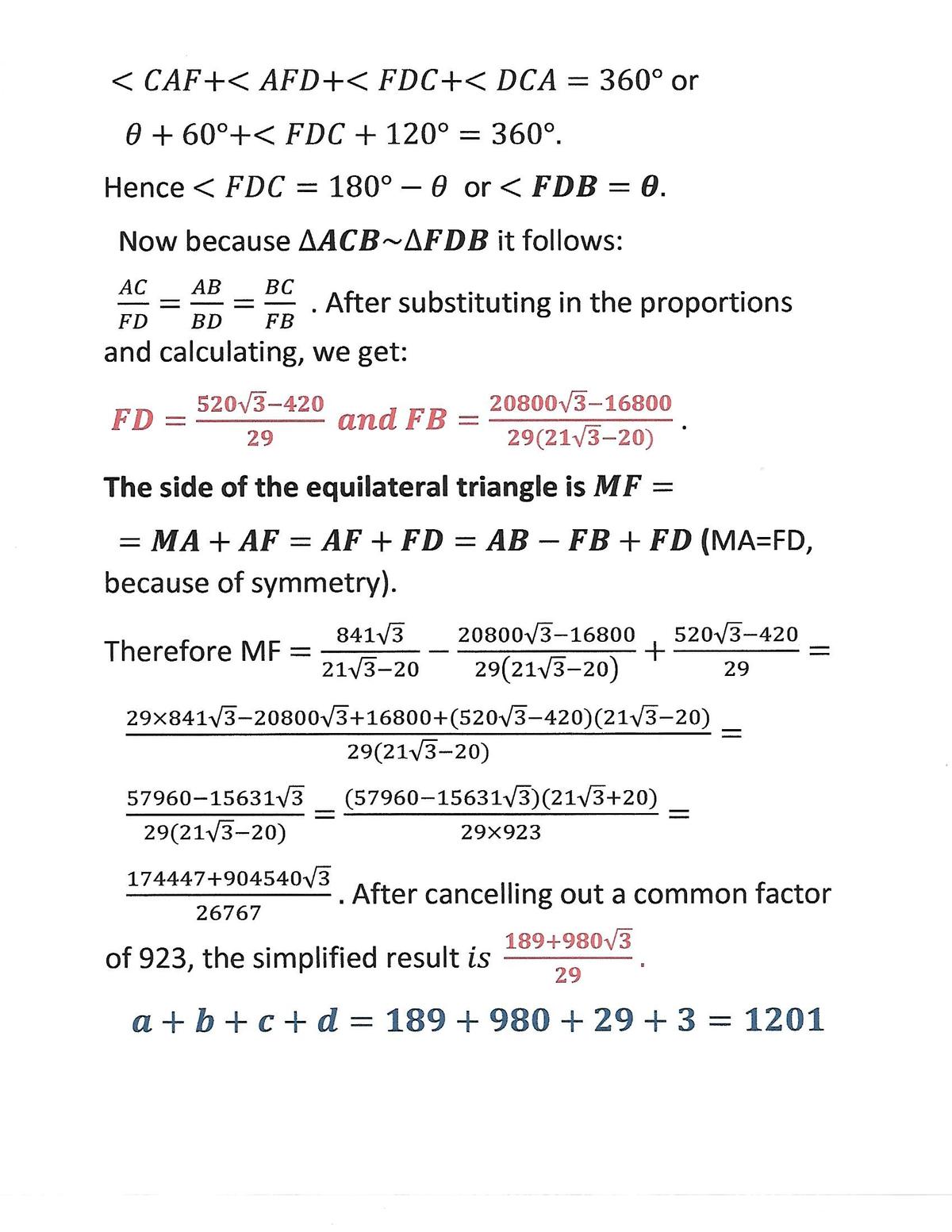Slid sectors
A circle of radius 2 0 is sliced into three congruent sectors, which are then slid apart to create a green equilateral triangle with side length 9 . A larger equilateral triangle is then circumscribed.
The side length of this large triangle can be written as c a + b d with d square-free and a , b , c irreducible.
What is the value of a + b + c + d ?
The answer is 1201.
This section requires Javascript.
You are seeing this because something didn't load right. We suggest you, (a) try
refreshing the page, (b) enabling javascript if it is disabled on your browser and,
finally, (c)
loading the
non-javascript version of this page
. We're sorry about the hassle.
5 solutions
This is better than my solution, except I can't figure out how you got cos θ
Log in to reply
I have added more details in the note. It is cos θ = Q T Q S . Q S = 2 0 , the radius of the circle and Q T = 2 0 + 9 radius of the circle + side length of the triangle.
Log in to reply
Jeremy how did you draw the figure of question??
Log in to reply
@Mr. India – I used geometer's sketchpad then altered the colors in ms paint. Brilliant admin appear to have made slight alterations as well.
Log in to reply
@Jeremy Galvagni – Any mobile app do you know??
very neat demonstration of the solution. i wonder how long did it take you :)
Log in to reply
I am quite use to it. All my solutions are this style. This one is probably 1 hour. I didn't really check.
Silly question. Asking for values of a b c d is like forcing one to find solution in a particular way. Just ask for side length. I got answer by simple geometry by deducing actual angles.
Really worked hard on this problem but question was wrongly asked.
Log in to reply
I wanted the exact answer, not an approximation. The approximation is too easy to find with a geometry drawing program. There are many ways to express the exact answer and I needed to choose one. I chose this format because it looks like solving a quadratic equation, although that's not how I solved it, nor did the other solvers.
There is not a single way to solve this problem. I actually solved some of the triangles and used the sum of arcsines rule.
I want to ask that cant these slides of cirlcle be arranged so that area of inner triangle be 0. So on that case the circle thus formed is incircle of the bigger triangle.
Let the points be labelled as shown, and draw B D so that B D ⊥ A H at B , and draw B C . Let θ = ∠ B D G , let a = B C , let b = A C , and let c = A B . By symmetry, G H = A C = b .

Since D G = 2 9 and B D = 2 0 , then by Pythagorean's Theorem on △ B D G , B G = 2 9 2 − 2 0 2 = 2 1 , and sin θ = 2 9 2 1 and cos θ = 2 9 2 0 .
Since ∠ C D E = 1 8 0 ° and ∠ E D F = 6 0 ° , ∠ E D F = 1 2 0 ° − θ . Since △ B C D is an isosceles triangle, ∠ D B C = 2 1 8 0 ° − ( 1 2 0 ° − θ ) = 3 0 ° + 2 θ . Since ∠ A B D is a right angle, ∠ A B C = 9 0 ° − ( 3 0 ° + 2 θ ) = 6 0 ° − 2 θ . Finally, since ∠ A B C = 6 0 ° − 2 θ and ∠ B A C = 6 0 ° , by triangle sum in △ A B C ∠ A C B = 1 8 0 ° − 6 0 ° − ( 6 0 ° − 2 θ ) = 6 0 ° + 2 θ .
By the law of sines on △ A B C , b = sin 6 0 ° a sin ( 6 0 ° − 2 θ ) and c = sin 6 0 ° a sin ( 6 0 ° + 2 θ ) . The side length A H is A H = A B + B G + G H = c + 2 1 + b which simplifies to A H = 2 1 + 2 a cos 2 θ .
Now a is a chord with central angle 1 2 0 ° − θ of a circle with radius 2 0 , so a = 2 ⋅ 2 0 sin 2 1 ( 1 2 0 ° − θ ) = 2 0 3 cos 2 θ − 2 0 sin 2 θ .
Substituting this value into A H and simplifying gives A H = 2 1 + 2 0 3 + 2 0 3 cos θ − 2 0 sin θ , and substituting sin θ = 2 9 2 1 and cos θ = 2 9 2 0 from above and simplifying gives 2 9 1 8 9 + 9 8 0 3 , which means a = 1 8 9 , b = 9 8 0 , c = 2 9 , and d = 3 ; and a + b + c + d = 1 8 9 + 9 8 0 + 2 9 + 3 = 1 2 0 1 .
Why 1201 is only solution possible. Nowhere in question its written a b and d have to be integers. Even decimal numbers are irreducable.
Why am i wrong if i get correct side length by some other decimal values of a b and d.
Log in to reply
I read the term "irreducible" to mean an " irreducible fraction ", which are made up of integers.
Why b+c equals 2acosq/2 ? Shouldn’t it be square root of 3?
Log in to reply
Since b = sin 6 0 ° a sin ( 6 0 ° − 2 θ ) and c = sin 6 0 ° a sin ( 6 0 ° + 2 θ ) ,
b + c
= sin 6 0 ° a sin ( 6 0 ° − 2 θ ) + sin 6 0 ° a sin ( 6 0 ° + 2 θ )
= sin 6 0 ° a ( sin ( 6 0 ° − 2 θ ) + sin ( 6 0 ° + 2 θ ) )
= sin 6 0 ° a ( ( sin 6 0 ° cos 2 θ − sin 2 θ cos 6 0 ° ) + ( sin 6 0 ° cos 2 θ + sin 2 θ cos 6 0 ° ) )
= sin 6 0 ° a ( 2 sin 6 0 ° cos 2 θ )
= 2 a cos 2 θ
While, the geometric solution using (20,21,29) right triangle, the side of large equilateral triangle is given by:
a = (189+980√3)/29,
However, the algebraic answer derived using the area relation:
(a^2-9^2)((√3)/4)=3(Area Quadrialteral)
Area Quadrilateral= Area of two triangles=(20×29+(a-b)×b)((√3)/4), where, b is the length between triangle and circle vertice on the side of the triangle.
gives an equation:
a^2 - 9^2=3×20×29 + 3(a-b)b
Solving this as Diophantine equation gives 'a' and 'b' as,
a=69 and b =20.
This algebraic integer value of a=69 is quite different from the geometric value of a=~65.048.
in this line : Area Quadrilateral= Area of two triangles=(20×29+(a-b)×b)((√3)/4), can you please explain which triangles did you pick? (you can reference to the illustration of @David Vreken if you dont want) GDA and ADC?
Log in to reply
Triangles on vertices H (60°) & F (120°) in David Vreken Diagram.
a and b are not coprimes, they share the common factor 7
Oops. What's the best way to word it? "Cannot be reduced"?
Log in to reply
...yeah, or that the greatest common denominator of a, b, c is 1. That should do it.


Due to symmetry, the two equilateral triangles share a common centroid O . The side length of the big equilateral triangle is given by 2 3 O P , where O P is the perpendicular distance between the centroid and the base. An O P is given by:
O P = Q S − Q R = Q S − O Q cos ( θ + 3 0 ∘ ) = 2 0 − 3 3 ( 2 3 cos θ − 2 1 sin θ ) = 2 0 − 3 3 ( 2 3 × 2 9 2 0 − 2 1 × 2 9 2 1 ) Let ∠ S Q T = θ Note that Q S = 2 0 , O Q = 9 × 2 3 × 3 2 = 3 3 and cos θ = Q T Q S = 2 0 + 9 2 0 = 2 9 2 0 , sin θ = 2 9 2 1
Therefore, the side length of the big equilateral triangle is:
2 3 O P = 2 3 ( 2 0 − 3 3 ( 2 3 × 2 9 2 0 − 2 1 × 2 9 2 1 ) ) = 4 0 3 − 2 9 1 8 0 3 − 1 8 9 = 2 9 1 8 9 + 9 8 0 3
Hence, a + b + c + d = 1 8 9 + 9 8 0 + 2 9 + 3 = 1 2 0 1 .